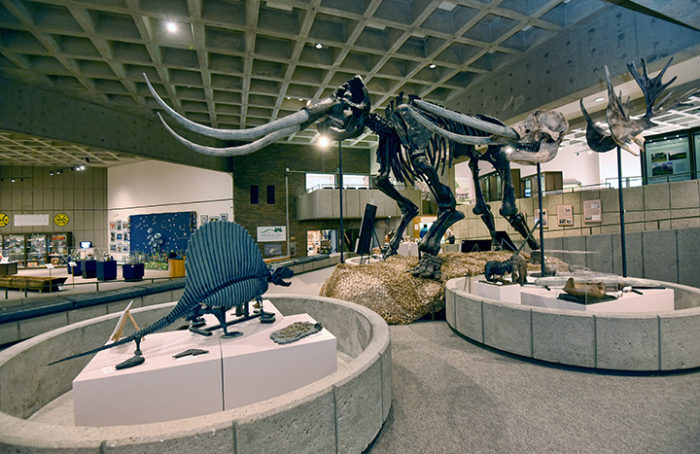
Operating Hours
Open Tuesday through Saturday
9:00 a.m. to 4:30 p.m.
Closed
Sundays and Mondays
Admission to the museum is free.
Contact
Main: (304) 843-4128
Grave Creek Mound Archaeological Complex
801 Jefferson Avenue
Moundsville, WV 26041
Recent News
-
04/26/2024
SHPO Day of Service and Remembrance Grants Applications Deadline Extended
-
04/26/2024
Department of Arts, Culture and History Now Accepting Submissions for the Inspired: West Virginia Historic Buildings and Structures Juried Art Exhibition
-
04/25/2024
Department of Arts, Culture and History Celebrates 50 Years of GOLDENSEAL Magazine with New Exhibit Opening
-
03/25/2024
Governor’s Arts Awards Presented 11 Awards to Individuals and Organizations and 10 Legislative Leadership Awards
-
03/25/2024
2024 Congressional Youth Art Competition Winners Announced
Exploring West Virginia Archaeology
The Grave Creek Archaeological Complex is home to multiple entities including a museum, an archaeological research center, and a National Register of Historic Places site. The mission of the complex is to preserve the site of the Grave Creek Mound, interpret the archaeological record of West Virginia for the public, and manage the state’s archaeological collections. The museum exhibits begin with fossils and ice age animals, a tour through archaeological sites in West Virginia, and then culminates with displays about the prehistoric Adena people and the construction of the Grave Creek Mound.
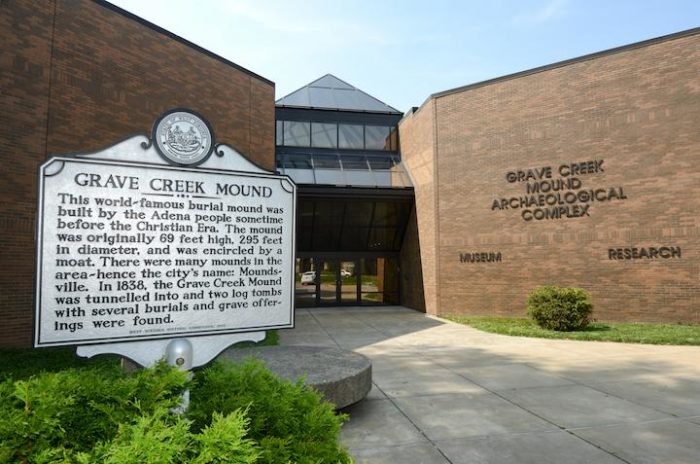
The complex organizes educational and professional programs throughout the year. Popular programs for the public include Garden Planting Days held in the spring, Fossil Day held in March and September, and the annual Archaeology Day event held in October. These educational events have activities for adults and children such as fossil identification, flint-knapping demonstrations, museum scavenger hunts, and atlatl throwing. The Lecture and Film Series presents programs on topics related to archaeology or Appalachian culture and history on designated Thursday evenings and Saturday afternoons. Next to the Mound, the outdoor Interpretative Garden showcases crops that were first cultivated by the indigenous people, such as gourds and sunflowers.
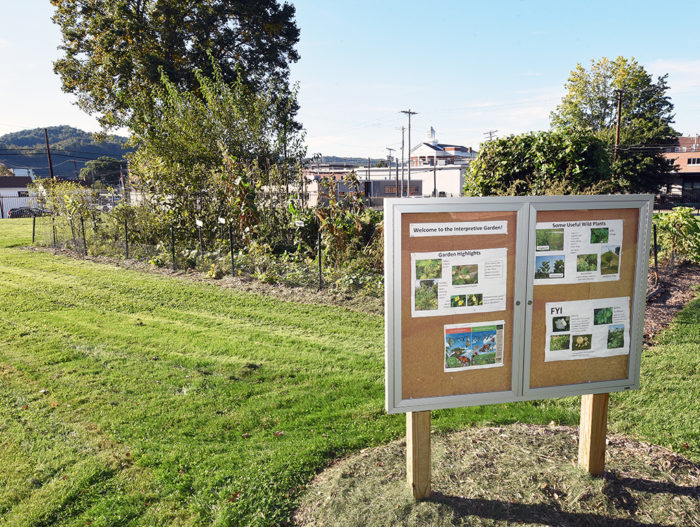
In addition to the museum and historical site, the facility maintains a gift shop specializing in West Virginia-made products, an outdoor picnic area, and a 136-seat theater. The Grave Creek Archaeological Complex is open year-round to visitors. A guided interpretative tour is available to groups with advance reservation. Group organizers are encouraged to contact the Complex for information regarding booking an introductory program and hands-on activities to enhance their museum experience.
The Mound and its Preservation
The heart of the Grave Creek Mound Archaeological Complex is the conical burial mound constructed by the prehistoric Native American cultural group termed the Adena by archaeologists.
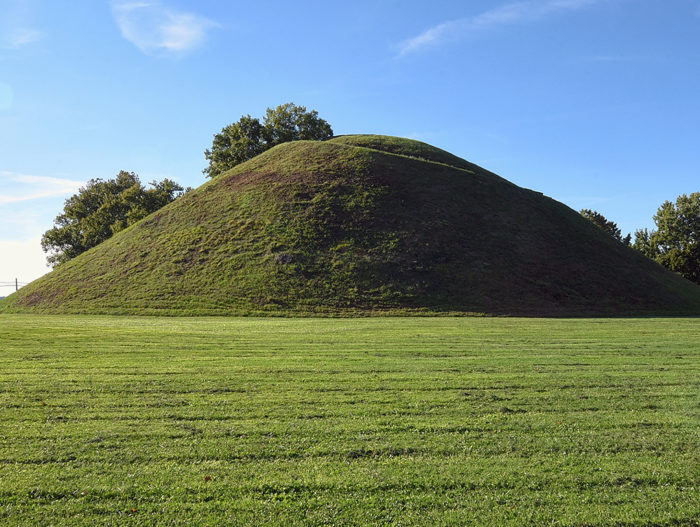
The Grave Creek Mound is one of the largest Adena mounds and an impressive sight for any visitor to Moundsville. A massive undertaking, the total effort required the movement of more than 57,000 tons of sand and earth. Construction of the mound took place from about 250-150 B.C. and included multiple burials at different levels within the structure. Originally a ditch about 40 feet wide and five feet deep encircled the mound and at least one causeway led up to the monumental structure. Although Grave Creek Mound is today an isolated feature on the landscape, the flat area now occupied by the city of Moundsville was once covered with small and large mounds and associated earthworks. Unfortunately, these structures and many others all over the region have been destroyed by treasure-hunters and farmers who plowed over these in the past.
The first recorded excavation of the mound took place in 1838 and was conducted by local amateurs. To gain entrance to the mound, two horizontal tunnels and one vertical shaft were dug. This led to the discovery of two burial vaults containing human remains and their grave goods, which may have been placed with them as reminders of the lives they once led, as offerings to the dead, or as equipment for the afterlife. In the 1970s the first professional archaeological investigation of Grave Creek Mound was conducted. This project involved systematically excavating multiple trenches around the base of the mound and extracting soil samples from the mound itself. The data garnered from this investigation provided radiocarbon dates for the mound and evidence for continuous construction by basket-loads of soil.
The Grave Creek Mound is an exceptional site. Although most mounds are much smaller than the Grave Creek Mound, the monumental size must have been an important and purposeful feature of its construction and likely led to its preservation by early landowners. Today, the mound is a vital physical reminder that the landscape was once populated by prehistoric Native American peoples and their mounds, villages, and earthworks.
The Grave Creek Mound, as well as other mounds and earthworks, are sacred sites to Native Americans. We ask that visitors reflect on the indigenous people who built the mound and conduct themselves with respect.
A Tour Through the Past
Adjacent to the 2,000-year burial mound, exhibits interpreting the lifeways of the Adena people are displayed in the Delf Norona Museum. Named after an amateur archaeologist and founding member of the West Virginia Archeological Society who advocated preservation of the mound, the Delf Norona Museum opened in December of 1978. The museum was designed with a natural brick façade and gabled skylights as an architectural tribute to the prehistoric past.
The lower gallery of the museum highlights the fossil record of West Virginia with exhibits such as life-sized ice age fossil casts including the state fossil of West Virginia, the ground sloth! In 1797, President Thomas Jefferson obtained and described fossil bones from a limestone cave in what is now Monroe County and in 2008 the West Virginia Legislature voted to recognize Megalonyx jeffersonii as the state fossil. The paleontology exhibit gives visitors a background of some of the animals that coexisted with the earliest Native American inhabitants of the Mountain State.
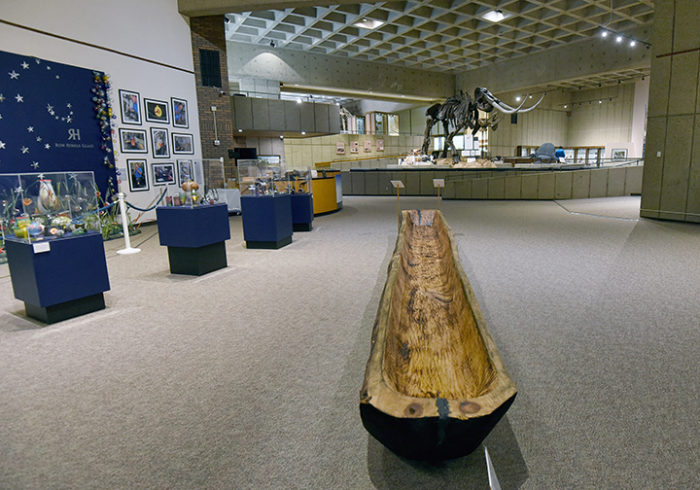
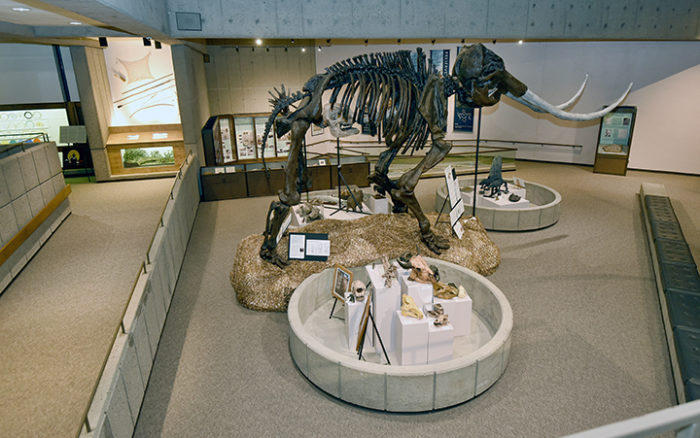
Also located in the lower gallery are exhibits that guide visitors through roughly 12,000 years of human habitation in West Virginia. Panels on sites such as St. Albans in Kanawha County and the Clifton Heights petroglyph from Ohio County provide information on how various indigenous peoples built homes, hunted or foraged for food, or grew crops in both upland and river valley environments. Other exhibits feature frontier sites with an array of colonial-era artifacts such as an ornate shoe buckle and a mold for making lead bullets. Lastly, some exhibits depict more recent history with artifacts from Blennerhassett Mansion and Victorian-era Wheeling.
The upper gallery of the museum focuses on Adena lifeways and the Grave Creek Mound. About 1000 B.C. marks the beginning of a major change in North America. Termed the Woodland Period and lasting until about 1200 A.D., this era is characterized by new ways of living, including permanent settlements and plant domestication. The first group of people to develop this unique way of life were the Adena, from about 1000 B.C. to about 200 A.D in the region of present-day Ohio, Indiana, West Virginia, Kentucky, and parts of Pennsylvania and New York.
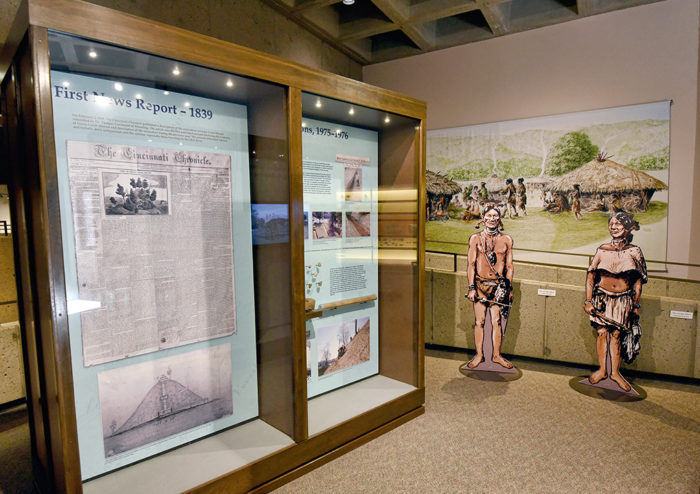
The Adena people constructed circular wooden structures ranging from 15 to 45 feet in diameter that may have been used for both domestic and ceremonial purposes. The walls consisted of paired posts tilted outward, joined to large wooden beams to form a conical-shaped roof. The roof was covered with bark, and the walls may have been bark, wickerwork, or some combination. A life-size replica of an Adena structure is on display in the upper gallery so that visitors can imagine prehistoric life.
The most well-known feature of Adena culture is the earthen mounds where people chose to bury some of their dead. Though not the only mound-builders, the Adena people expertly engineered conical burial mounds that have stood the test of time with little to no modern intervention. The labor of many people must have been required to build these mounds with large amounts of earth moved by the basket-load. Perhaps for this reason, the mounds were often used more than once. In many mounds, there are multiple burials at different levels. Some individuals were laid to rest with a variety of grave goods such as flint tools, beads, pipes, and mica and copper ornaments.
Archaeological Research Today
Completed in 2008, the West Virginia Archaeological Research and Collections Management Facility was added onto the museum building and is the repository for all state-owned archaeological collections and artifacts.
The archaeologists working in the research facility process artifacts and archives, maintain the state’s archaeological collections, and conduct original research. In addition, the facility welcomes researchers and students to conduct novel studies using the archives or artifacts housed in the repository. Prospective visitors to the archaeological research facility must arrange visits in advance with one of the curators.
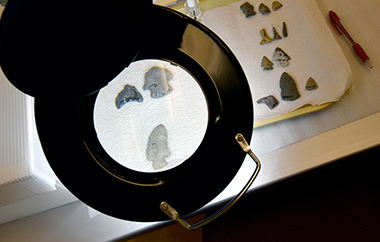
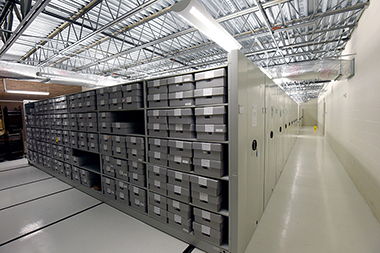
shelving system
The Grave Creek Mound stands as a testament to the ingenuity of prehistoric Native Americans while the Grave Creek Mound Archaeological Complex is a modern commitment to preserve and exhibit the past. We welcome visitors to experience the vast history of the Mountain State.
